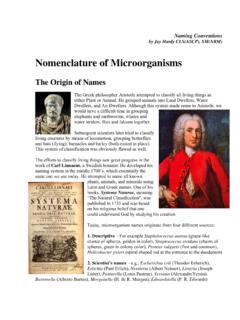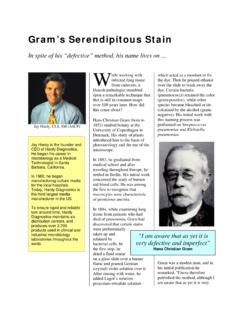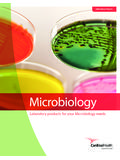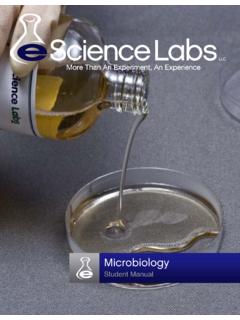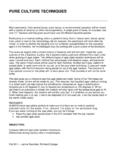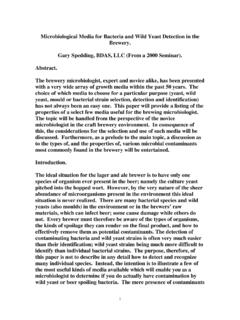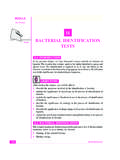Transcription of AGAR and the Quest to Isolate Pure Cultures
1 AGAR and the Quest to Isolate Pure Cultures fanny hesse s invention that changed microbiology forever Jay Hardy, MT, SM (ASCP) ver wonder where the idea of using seaweed derived agar in culture media came from? We owe a lab scientist named fanny hesse for this ingenious invention. Let s go back to the time before solid culture media was discovered. In the early 1880 s, Robert Koch began his studies of bacteria in Germany using only nutrient broth Cultures . Not having a reliable way to Isolate pure strains of bacteria was a persistent problem in his laboratory.
2 He tried doing serial dilutions of diseased tissue in order to yield a broth of a single organism. This had limited success, since it was usually the predominant organism that would appear in the diluted broth and not necessarily the pathogen he was looking for. Koch noticed that when a sliced potato was left out in the open, it would eventually produce tiny spots that appeared on the surface. This gave him the idea to use thinly sliced potatoes as a culture medium that could be streaked in order to obtain isolated colonies.
3 This technique was used in his discovery of the anthrax pathogen, Bacillus anthracis. However, not all bacteria would thrive on this innovative but crude culture media. A better method was needed. Subsequently, Koch tried using media with gelatin as a solidifying agent. He encountered two problems here. First, on warm days, the media would liquefy; second, many types of bacteria possessed enzymes that were E Jay Hardy is the founder and CEO of Hardy Diagnostics. He began his career in microbiology as a Medical Technologist in Santa Barbara, California.
4 In 1980, he began manufacturing culture media for the local hospitals. Today, Hardy Diagnostics is the third largest media manufacturer in the US, and produces over 2,700 products used in clinical and industrial microbiology laboratories. After trying broths, potatoes, and gelatin, fanny was the one that finally came up with the answer to the problem of obtaining pure Cultures . capable of digesting the gelatin. Frustrated by the gooey mess in his culture dishes, Koch and his associates became increasingly discouraged by the difficulty of isolating pure strains of bacteria.
5 All this changed in 1881, when Walter hesse and his wife, fanny , joined Koch s lab in Germany. Her full maiden name was fanny Angelina Eilshemius, a German-American born in New York City. Walter was studying airborne microorganisms, and fanny assisted him in the lab where she drew beautiful illustrations of what they saw in the microscope. One day in 1881, while eating lunch, Walter asked fanny about the jellies and puddings that she made and how they managed to stay gelled even in warm weather. Fannie told him about how she learned about the seaweed product, agar-agar, from a Dutch neighbor of hers while she was growing up in New York City.
6 Her neighbor had emigrated from Indonesia, where it was the local custom to use agar in their cooking. Fannie suggested that they try this out in their laboratory. The rest is history. Agar turned out to be an ideal gelling agent that stayed firm even in the incubator and could not be digested by any bacterial enzymes. Walter hesse notified Koch of this new technique, who immediately added agar to his nutrient broths. Koch used this new solid media to Isolate the tubercle bacillus. He eventually discovered the etiologic agents of 21 diseases including tuberculosis, plague, malaria, and cholera; achieving the biggest advance ever in clinical microbiology !
7 fanny and Walter hesse , 1881 Robert Koch, the Father of Clinical microbiology . Walter and fanny received no monetary reward for their invention. There was never any mention made of their discovery in the scientific literature of that day. However, today we fully recognize the value of their discovery and still utilize their invention as we remain indebted to their ingenuity. Gracilaria and Gelidium are the two types of red algae used in the commercial preparation of agar. Jay Hardy, MT, SM (ASCP) Hardy Diagnostics Santa Maria, CA Red algae is harvested mainly on the coast of Spain, Portugal, and Mexico.
8

